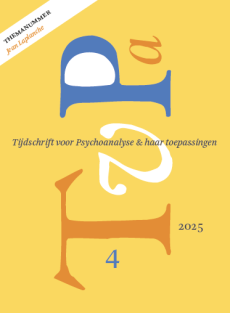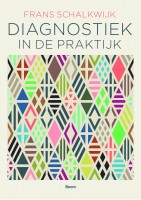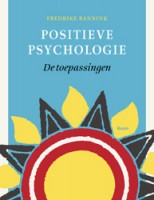Werkelijkheid en intersubjectiviteit in de perversies
Summary
Reality and intersubjectivity in perversion
This paper is devoted to a relatively new concept pointing to a specific psychic reality which manifests itself only in the transference-countertransference. Due to a perverse collated internal object, the fantasy-system with which we approach the reality of the object-world, a splitting of the ego occurs, leading to a perversity. A vitalizing interaction between reality symbolized by the inner world and material external reality is blocked. Excitement and the intention to involve the analyst in it, as well as a disavowal of normal, oedipal reality, are used as defences against an intense sense of inner deadness. As a consequence, intersubjective reality which can be shared with other people is distorted by a perverse process. The manifestation of neurotic and perverse processes side by side in a psychoanalytic treatment, as well as the technical problems confronting an analyst, are illustrated through a clinical example.
Literatuur
- Arlow, J.A. (1969). Unconscious fantasy and disturbances of conscious experience. Psychoanalytic Quarterly, 38, 1-27.
- Arlow, J.A. (1996). The concept of psychic reality how useful? International Journal of Psychoanalysis, 77, 659-667.
- Berenstein, I. (2001). The link and the other. International Journal of Psychoanalysis, 82, 141-150.
- Campbell, D. (2007). Technical difficulties and challenges in psychoanalytic work with perverse patients. Ongepubliceerde voordracht en discussie op het IPA-congres te Berlijn.
- Cavell, M. (2006). Becoming a subject: reflections in philosophy and psychoanalysis. New York: Oxford University Press.
- Coultre, R. le (1966 / 1993). Splijting van het Ik als centraal neurose verschijnsel. In Engelse vertaling: Splitting of the ego, as the central phenomenon in neurosis, edited by Michael E. Chayes, 1993. International Journal of Psychoanalysis, 74, 791-802.
- Danckwardt, J.F. (2007). From Dream story (Schnitzler) to Eyes wide shut (Kubrick) From identity through meaning formation to identity through excitation. International Journal of Psychoanalysis, 88, 147-167.
- Eiguer, A. (1996). The status of psychic reality in adolescence. International Journal of Psychoanalysis, 77, 1169-1179.
- Eiguer, A. (1999). Cynism: its function in the perversion. International Journal of Psychoanalysis, 80, 671-684.
- Eiguer, A. (2007). The intersubjective links in the perversion. International Journal of Psychoanalysis, 88, 1135-1152.
- Fonagy, P. & Target, M. (2007). Playing with reality: IV. A theory of external reality rooted in intersubjectivity. International Journal of Psychoanalysis, 88, 917-937.
- Freud, S. (1905). Drei Abhandlungen zur Sexualtheorie. Studienausgabe 5 (p. 47-145). Frankfurt am Main: Fisher Verlag.
- Freud, S. (1938). Die Ichspaltung im Abwehrvorgang. Studienausgabe 3 (p. 391-394). Frankfurt am Main: Fisher Verlag.
- Freud, S. (1940). Hoofdlijnen van de psychoanalyse. Werken 10 (p. 447-503). Amsterdam: Boom.
- Glover, E. (1933). The relation of perversion-formation to the development of reality sense. International Journal of Psychoanalysis, 14, 486-504.
- Good, M.I. (2006). Perverse dreams and dreams of perversion. Psychoanalytic Quarterly, 75, 4, 1005 -1044.
- Greenacre, P. (1953). Certain relationships between fetishism and faulty development in the body image. Psychoanalytic Study of the Child, 8, 79-98.
- Jiménez, J.P. (2004). A psychoanalytic phenomenology of perversion. International Journal of Psychoanalysis, 85, 63-81.
- Joseph, B. (1971). A clinical contribution to the analysis of perversion. International Journal of Psychoanalysis, 52, 441-449.
- Kahn, M.M.R. (1979). Alienation in perversions. Londen: Hogarth Press.
- Laplanche, J. & Pontalis, J-B. (1973). The language of psychoanalysis. Londen: The Hogarth Press.
- Maidman, P. (1996). Over een geval van fetisjisme bij een kind. Tijdschrift voor psychoanalyse, 2, 146-157.
- Ogden, Th.H. (1996). The perverse subject of analysis. Journal of the American Psychoanalytic Association, 44, 1121-1146.
- Ruelens, L. (2007). Perversie, drift en sublimatie Commentaar bij Neurotische en perverse processen (Ubbels, 2007). Tijdschrift voor psychoanalyse, 13, 271-274.
- Stufkens, A. (2007). Een weerbarstige werkelijkheid Commentaar bij Neurotische en perverse processen (Ubbels, 2007). Tijdschrift voor psychoanalyse, 13, 274-276.
- Temmerman, K. & F. Geerardyn (2007). Perverse structuur versus perverse trek Mechanismen versus fenomenologie Commentaar bij Neurotische en perverse processen (Ubbels, 2007). Tijdschrift voor psychoanalyse, 13, 277-279.
- Ubbels, J. (2007). Neurotische en perverse processen. Tijdschrift voor psychoanalyse, 13, 259-270.
- Wille, R. (2007). Bijdrage aan de discussie na mijn voordracht op 3 september 2007 voor de gezamenlijke wetenschappelijke avond van drie Nederlandse psychoanalytische verenigingen.
- Winnicott, D.W. (1971). Playing and reality. Londen: Tavistock Publications.
 © 2009-2025 Uitgeverij Boom Amsterdam
© 2009-2025 Uitgeverij Boom Amsterdam
ISSN 1382-516x
De artikelen uit de (online)tijdschriften van Uitgeverij Boom zijn auteursrechtelijk beschermd. U kunt er natuurlijk uit citeren (voorzien van een bronvermelding) maar voor reproductie in welke vorm dan ook moet toestemming aan de uitgever worden gevraagd:
Behoudens de in of krachtens de Auteurswet van 1912 gestelde uitzonderingen mag niets uit deze uitgave worden verveelvoudigd, opgeslagen in een geautomatiseerd gegevensbestand, of openbaar gemaakt, in enige vorm of op enige wijze, hetzij elektronisch, mechanisch door fotokopieën, opnamen of enig andere manier, zonder voorafgaande schriftelijke toestemming van de uitgever.
Voor zover het maken van kopieën uit deze uitgave is toegestaan op grond van artikelen 16h t/m 16m Auteurswet 1912 jo. Besluit van 27 november 2002, Stb 575, dient men de daarvoor wettelijk verschuldigde vergoeding te voldoen aan de Stichting Reprorecht te Hoofddorp (postbus 3060, 2130 KB, www.reprorecht.nl) of contact op te nemen met de uitgever voor het treffen van een rechtstreekse regeling in de zin van art. 16l, vijfde lid, Auteurswet 1912.
Voor het overnemen van gedeelte(n) uit deze uitgave in bloemlezingen, readers en andere compilatiewerken (artikel 16, Auteurswet 1912) kan men zich wenden tot de Stichting PRO (Stichting Publicatie- en Reproductierechten, postbus 3060, 2130 KB Hoofddorp, www.cedar.nl/pro).
No part of this book may be reproduced in any way whatsoever without the written permission of the publisher.
Nieuwsbrief Boom Psychologie
Meld u nu aan en ontvang maandelijks de Boom Psychologie nieuwsbrief met aantrekkelijke aanbiedingen en de nieuwe uitgaven.
Aanmelden


